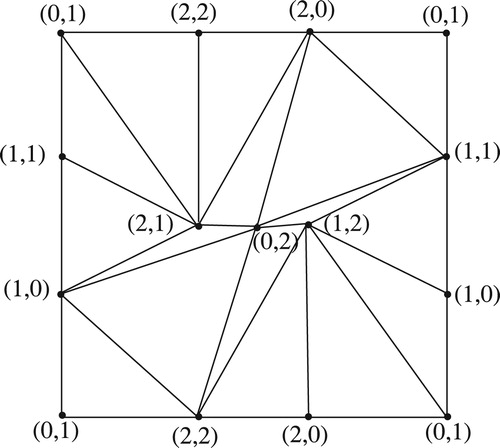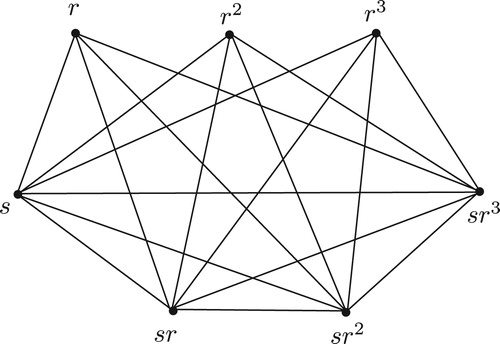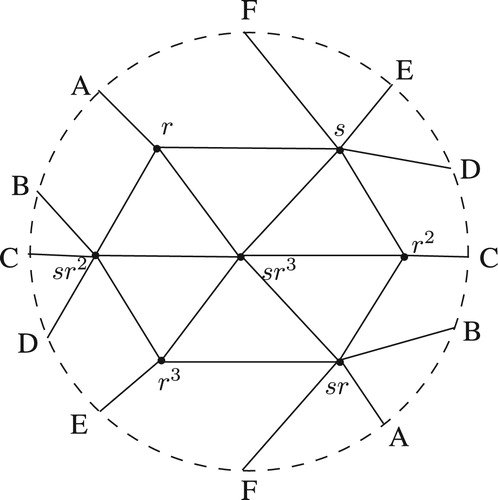Abstract
The non-cyclic graph to a non locally cyclic group
is as follows: take
as vertex set, where
is called the cyclicizer of
, and join two vertices if they do not generate a cyclic subgroup. In this paper, we classify the finite groups whose non-cyclic graphs are outerplanar. Also all finite groups whose non-cyclic graphs can be embedded on the torus or projective plane are classified.
1 Introduction
In order to get a better understanding of a given algebraic structure , one can associate to it a graph
and study an interplay of algebraic properties of
and combinatorial properties of
. In particular there are many ways to associate a graph to a group. For example commuting graph of groups, non-commuting graph of groups, non-cyclic graph of groups and generating graph of group have attracted many researchers towards this dimension. One can refer [1–6Citation[1]Citation[2]Citation[3]Citation[4]Citation[5]Citation[6]] for such studies.
Let be a non locally cyclic group. In [Citation1], Abdollahi and Hassanabadi introduced the graph
of
defined as follows: take
as vertex set, where
is called the cyclicizer of
, and join two vertices if they do not generate a cyclic subgroup. Especially, the embeddings of non-cyclic graph
help us to explore some interesting results related to algebraic structures of groups. In this paper, we try to classify all finite groups whose non-cyclic graphs are outerplanar and it can be embedded on the torus or projective plane.
By a graph , we mean an undirected simple graph with vertex set
and edge set
. A graph in which each pair of distinct vertices is joined by the edge is called a complete graph. We use
to denote the complete graph with
vertices. An
-partite graph is one whose vertex set can be partitioned into
subsets so that no edge has both ends in any one subset. A complete
-partite graph is one in which each vertex is joined to every vertex that is not in the same subset. The complete bipartite graph (2-partite graph) with part sizes
and
is denoted by
. A graph
is said to be planar if it can be drawn in the plane so that its edges intersect only at their ends. A subdivision of a graph is a graph obtained from it by replacing edges with pairwise internally-disjoint paths. A remarkably simple characterization of planar graphs was given by Kuratowski in 1930. Kuratowski’s Theorem says that a graph
is planar if and only if it contains no subdivision of
or
(see [Citation7, p. 153]).
By a surface, we mean a connected two-dimensional real manifold, i.e., a connected topological space such that each point has a neighborhood homeomorphic to an open disk. It is well known that any compact surface is either homeomorphic to a sphere, or to a connected sum of tori, or to a connected sum of
projective planes (see [Citation8, Theorem 5.1]). We denote
for the surface formed by a connected sum of
tori, and
for the one formed by a connected sum of
projective planes. The number
is called the genus of the surface
and
is called the crosscap of
. When considering the orientability, the surfaces
and sphere are among the orientable class and the surfaces
are among the non-orientable one. In this paper, we mainly focus on the non-orientable cases.
A simple graph which can be embedded in but not in
is called a graph of genus
. Similarly, if it can be embedded in
but not in
, then we call it a graph of crosscap
. The notations
and
are denoted for the genus and crosscap of a graph
, respectively. It is easy to see that
and
for all subgraphs
of
. For details on the notion of embedding of graphs in surface, one can refer to A.T. White [Citation9].
The following results are useful in the following subsequent section.
Theorem 1.1
[Citation10]
For positive integers and
, we have the following:
(i) if
;
(ii) if
.
Theorem 1.2
[Citation10]
Let be integers and for a real number
is the least integer that is greater than or equal to
. Then
(i)
(ii) , where
.
Theorem 1.3
[Citation10]
Let be a simple graph with
vertices
and
edges. Then
.
Theorem 1.4
[Citation10]
Let be a connected graph with
vertices and
edges. Then
.
2 Crosscap of non-cyclic graph
In this paper, we try to classify all finite groups whose non-cyclic graphs are outerplanar and it can be embedded on the torus or projective plane. The following are useful in the sequel of this section and hence given below:
Theorem 2.1
[Citation2]
Let be a group of size
and exponent
, where
is a prime number and
is an integer. Then
.
Theorem 2.2
[Citation2]
Let be a non locally cyclic group. Then
is planar if and only if
is isomorphic to
.
An undirected graph is an outerplanar graph if it can be drawn in the plane without crossings in such a way that all of the vertices belong to the unbounded face of the drawing. There is a characterization for outerplanar graphs that says that a graph is outerplanar if and only if it does not contain a subdivision of or
.
Theorem 2.3
Let be a finite non-cyclic group. Then
is outerplanar if and only if
.
Proof
Assume that is outerplanar. Then we have
. Suppose
. Since
is connected, there exist
such that
is non-cyclic. Therefore
make
a subgraph, which is a contradiction. Suppose that
contains an element
such that
. Then
where
is non-cyclic, make a subgraph isomorphic to
, which is again a contradiction. Thus
with exponent 2, where
. By Theorem 2.1,
and so
. □
Theorem 2.4
Let be a finite non locally cyclic group. Then
if and only if
is isomorphic to one of the following groups:
,
,
,
,
.
Proof
Assume that . Since
and
we have,
. Using this,
Since
for all
, we get,
which implies that 2
. Suppose that
. Then the subgraph induced by
is isomorphic to
and so
is a subgraph of
. Hence
and so
and by Theorem 2.2,
. Since
is not cyclic,
.
If , then by using Theorem 2.2,
is isomorphic to
,
, or
.
If , then
is isomorphic to
. If
, then
and so the vertex sets
and
make
a subgraph, which is a contradiction.
If , then
,
or
. Suppose
. Since
has 3 elements of order 2 and 8 elements of order 3, these elements make
a subgraph of
, which is a contradiction. If
, then
is a subgraph of
and hence
. If
, then we can find a suitable set of vertices such that they make
a subgraph, a contradiction. Hence
.
If , then
. Since
is a subgraph of
,
. If
, then
is isomorphic to one of the following groups:
Then we can find a suitable set of vertices such that they make either or
as a subgraph and so
, a contradiction.
Conversely, suppose or
. Then
is a subgraph of
and by Theorem 1.1,
. If
, then
and so
. By Figs. 1a and 1b,
. Since
is isomorphic
and
. □
The following theorems are used in Theorem 2.7.
Theorem 2.5
[Citation2]
Let be a finite non-cyclic group. Then
. Moreover
, where
is the number of maximal cyclic subgroups of
.
Theorem 2.6
See [Citation11]
Let be a finite
-group for some prime
. Then
if and only if
is either a cyclic group or a generalized quaternion group.
A covering for a group is a collection of proper subgroups of
whose union is
. For
, an
-cover for a group
is a cover with
members. A cover is irredundant if no proper subcollection is also a cover. We write
for the largest index
over all groups G having an irredundant
-cover with intersection
. Abdollahi et al. obtained
(see [Citation12]). We use these results to prove the following theorem.
Theorem 2.7
Let be a finite non-cyclic group. Then
if and only if
is isomorphic to one of the following groups:
or
.
Proof
Assume that . Suppose that
. Let
such that
is non-cyclic. Since
is non-locally cyclic finite group, there exists
and so
is a subgraph of the graph induced by the elements of
in
. Hence
.
Suppose that . Suppose
is not a
-group, where
is prime. Then there exists an element
such that
. Since
is non-empty, there exists
such that
is non-cyclic. Therefore
, makes a subgraph isomorphic to
, which is a contradiction. Thus
for all
. Since
,
is a 2-group and so by Theorem 2.3,
for some
. By Theorem 2.6 and by hypothesis,
is a generalized quaternion group and
contains an element of order
. If
, then there exist
and
in
such that
is non-cyclic and so
, makes a subgraph isomorphic to
, which is a contradiction. Therefore
and so
, a contradiction. Hence
.
If contains an element
such that
, then
where
is a suitable power of
such that
and
, makes a subgraph isomorphic to
, which is a contradiction. Therefore
, that is
. Since
and by Theorem 2.5,
contains at most 6 maximal cyclic subgroups. But
. Thus
. Since
,
. Since
where
.
Now we consider the following cases.
(i) If , then
or 3. Then
is isomorphic to
,
,
. If
, then
contains 8 vertices and 24 edges. Then by Theorem 1.4,
, which contradicts to our hypothesis. If
, then by Theorem 2.1,
is a clique of
, which is not possible. Since
is a subgraph of
,
.
(ii) If , then
or 2. If
, then
and
is isomorphic to
, which is a contradiction. Suppose
, then
is isomorphic to
and by (i),
.
(iii) If , then
or 2. If
, then
is isomorphic to
. Since every element of order 2 is adjacent to every element of order 3,
is a subgraph of
and hence
. Suppose
, then there is no group that satisfies the required conditions.
(iv) If , then
. If
, then
is isomorphic to
or
. Since
is a subgraph of
(see Figs. 2a and 2b) and by ,
or
. By Theorem 2.1,
is isomorphic to
and hence
, which is not possible. If
, then
is isomorphic to
. Since
is a subgraph of
,
.
(v) If , then
must be 0 and so
or 25. If
, then
is isomorphic to the following groups.
If is isomorphic to
, then by Theorem 2.1,
and so
, which is a contradiction. If
is isomorphic to the remaining groups, we can find a suitable set of vertices such that they make
as a subgraph and so
.
If , then
is isomorphic to the following groups (see [Citation13]).
But it is easily seen that
contains either
or
as a subgraph, which completes the proof. □
Notes
Peer review under responsibility of Kalasalingam University.
References
- A.AbdollahiA.Mohammadi HassanabadiNon-cyclic graph of a groupComm. Algebra35200720572081
- A.AbdollahiA.Mohammadi HassanabadiNon-cyclic graph associated with a groupJ. Algebra Appl.82009243257
- D.BundyThe connectivity of commuting graphsJ. Combin. Theory, Ser. A113620069951007
- A.AbdollahiS.AkbariH.R.MaimaniNon-commuting graph of a groupJ. Algebra2982006468492
- T.BreuerR.M.GuralneikA.LucchiniA.MarotiG.P.NagyHamiltonian cycles in the generating graphs of finite groupsBull. Lond. Math. Soc.422010621633
- A.R.MoghaddamfarW.J.ShiW.ZhouA.R.ZokayiOn the noncommuting graph associated with a finite groupSib. Math. J.4622005325332
- J.A.BondyU.S.R.MurtyGraph Theory with Applications1976American ElsevierNew York
- W.MasseyAlgebraic Topology: An Introduction1967Harcourt, Brace & World, Inc.New York
- A.T.WhiteGraphs, Gruops and SurfacesNorth-Holland Mathematics Studies1984North-HollandAmsterdam, The Netherlands
- MoharBojanThomaseenCarstenGraphs on Surfaces2001The John Hopkins University PressBaltimore
- K. O’Bryant, D. Patrick, L. Smithline, E. Wepsic, Some Facts About Cycles and Tidy Groups, Rose-Hulman Institute of Technology, Indiana, USA, Technical Report MS-TR 92–04, 1992.
- A.AbdollahiM.J.AtaeiS.M.Jafarian AmiriA.Mohammadi HassanabadiGroups with a maximal irredundant 6-coverComm. Algebra33200532253238
- K.M.ParattuA.WingerterTribimaximal mixing from small groupsPhys. Rev. D842011 013011
Further reading
- D.F.AndersonJ.FasteenJ.D.LaGrangeThe subgroup graph of a groupArab. J. Math.120121727
- M.BaziarE.MomtahanS.SafaeeyanZero-divisor graph of abelian groupsJ. Algebra Appl.132014 (13 p.)
- F.DeMeyerL.DeMeyerZero-divisor graphs of semigroupsJ. Algebra28312005190198
- F.DeMeyerT.McKenzieK.SchneiderThe zero-divisor graph of a commutative semi-groupSemigroup Forum6522002206214





